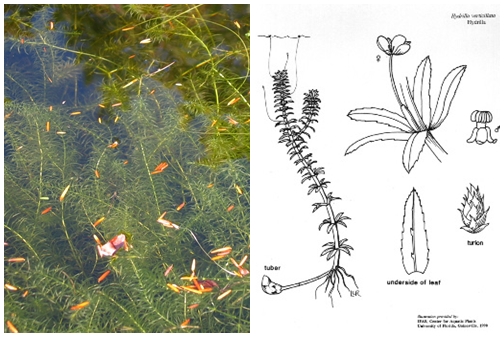Home → Water Quality → Monitoring → Invasives → Hydrilla
Hydrilla
Hydrilla verticillata

Photo: Maine DEP. Drawing: University of Florida/IFAS Center for Aquatic and Invasive Plants.
Description
Hydrilla is a submerged plant with long slender, branching stems. The leaves are small, strap-like, and pointed with tiny serrations along the outer margins. They are arranged in whorls of 4 - 8 along the stem. Hydrilla can easily be confused with Maine 's native waterweeds, however, only hydrilla forms small underground tubers. This plant produces tiny white flowers that rise to the surface on slender stalks. It grows in large dense beds.
General Information
Hydrilla is a native to Africa and is considered the most problematic invasive plant in North America. Hydrilla was confirmed in a 46-acre lake in southwestern Maine in 2002. It is also present in nearby Massachusetts, Connecticut and New Jersey.
Hydrilla is a prolific weed that forms stems reaching up to 30 feet in length. It is able to dominate fresh water ecosystems quickly when fragmented by boat props and by way of winter buds, underground tubers and surface runners. The aquatic weed also tolerates a wide range of environmental conditions including low light levels, high or low nutrient waters, and freezing temperatures. Hydrilla can not only out-compete native aquatic plants, it can infest a lake more aggressively than variable water milfoil, the most common invasive plant established in Maine.